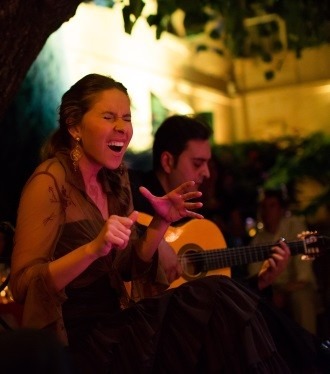Barcelona Flamenco Ballet fuses three dance styles with which we are all familiar – jazz, contemporary and, of course, flamenco – although the integration of the three results in a totally innovative onstage presence. Creating a tension so electric, the metallic tapping sounds of the dancers’ footwork endure in one’s ears, leaving us questioning: what does it mean to be ‘reborn’ in this production?
One interpretation of ‘reborn’ in Barcelona Flamenco Ballet is that of reconstruction. The dancers are constantly reconstructing the ambiances they produce onstage. They build up a movement, or a rhythm, with repetitive, vigorous motions – and then break it, instantly stopping, rupturing the established order, then beginning again, with a new movement, a new rhythm. In this way the rhythm itself is ‘reborn’ – constantly renewing the dynamics of the performance, keeping it fresh and alive. These transitions from the exuberant outpourings of passion to quiet moments of intimacy mean that the production is constantly in fluctuation, in a process of reinvention.
We also see the performers being ‘reborn’ through their discovery and claiming of flamenco. Initially, their formal, tight clothing restricts and restrains them. They are prevented from moving freely, every motion they make is stiff. However, as the music grows, they find a harmony between their bodies and the music – like the flamenco has helped them rediscover a part of themselves, a new part which they have been able to liberate.
Moreover, the relationship between performers and audience is found to be ‘reborn’ or reclaimed throughout Barcelona Flamenco Ballet. Due to their initial reserve, the boundaries between artist and spectator are rigid; fixed – audience are aware that it is a staged performance they are watching. However, as their performing and spirits become more liberated, the dancers and musicians open up a stronger dialogue with the audience. They become more casual and conversational with the audience. It is like the performer’s natural personality is able to come to the surface – now untainted from any distinctive ‘performer mask’. Consequently, the audience respond in a corresponding trajectory – engaging with how the performers move and with what they say. So in this way, not only are the performers reborn – but do spectators manage to find a sense of reinvention too?
Barcelona Flamenco Ballet, in its monumental grandeur, possesses a symbolic, almost expressionist aspect, which is seen in its evocative use of colour. Blue stage lighting is used to highlight the quieter moments, when a dancer is performing solo – to represent solitude and reflecting the performer’s finding peace within themselves. A dark, black stage, lit by a single spotlight, portrays a moment of tension building, often with added smoke for emphasis. Most significantly, the dramatic red effects engender a sense of the unusual, the strange, or the uncanny. Red connotes a diverse number of meanings and symbols: danger, passion, fear, pain, blood – all characteristics of Spain as a nation and Spanish identity. In this way, Barcelona Flamenco Ballet is not just a dance performance – but a work of art.











